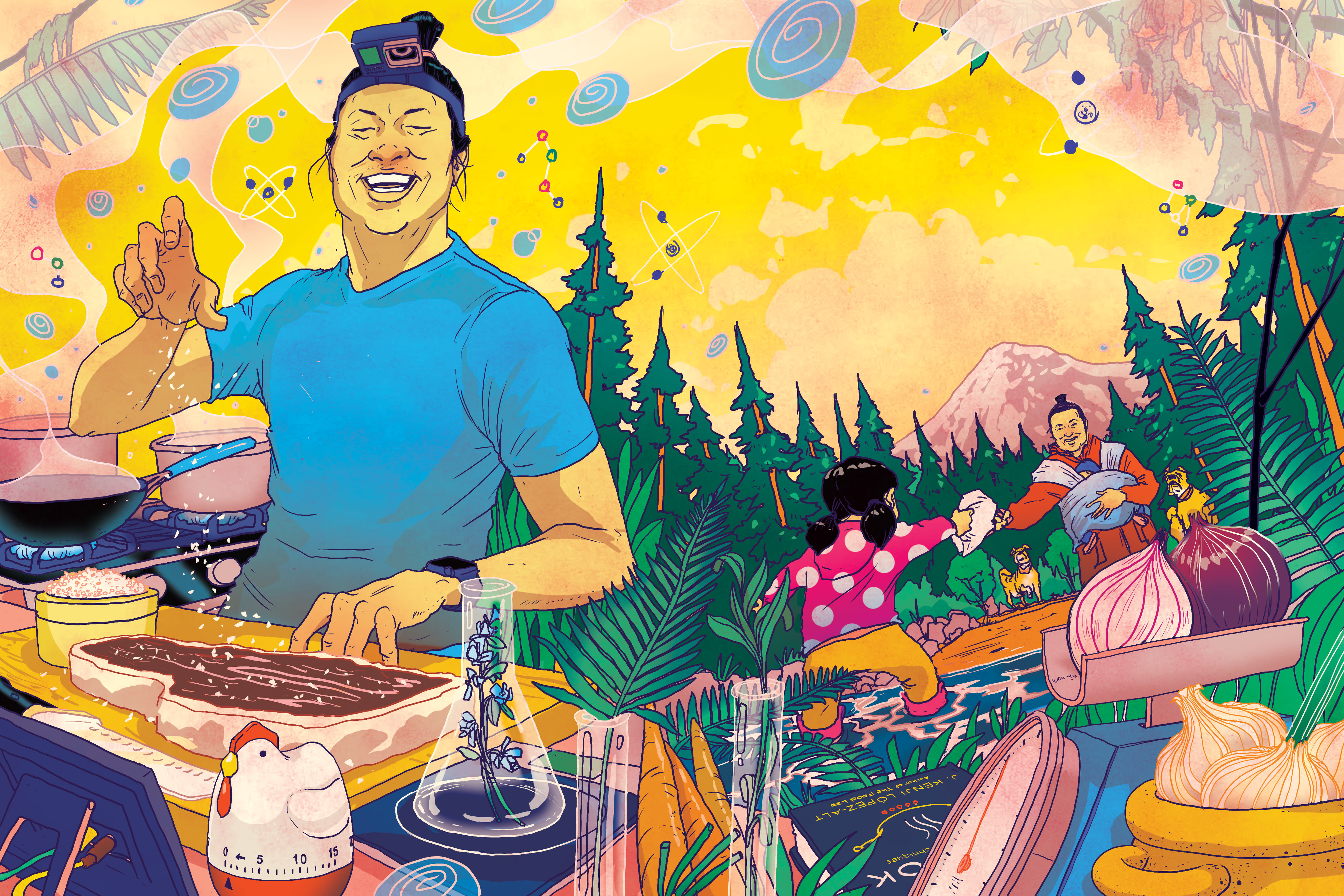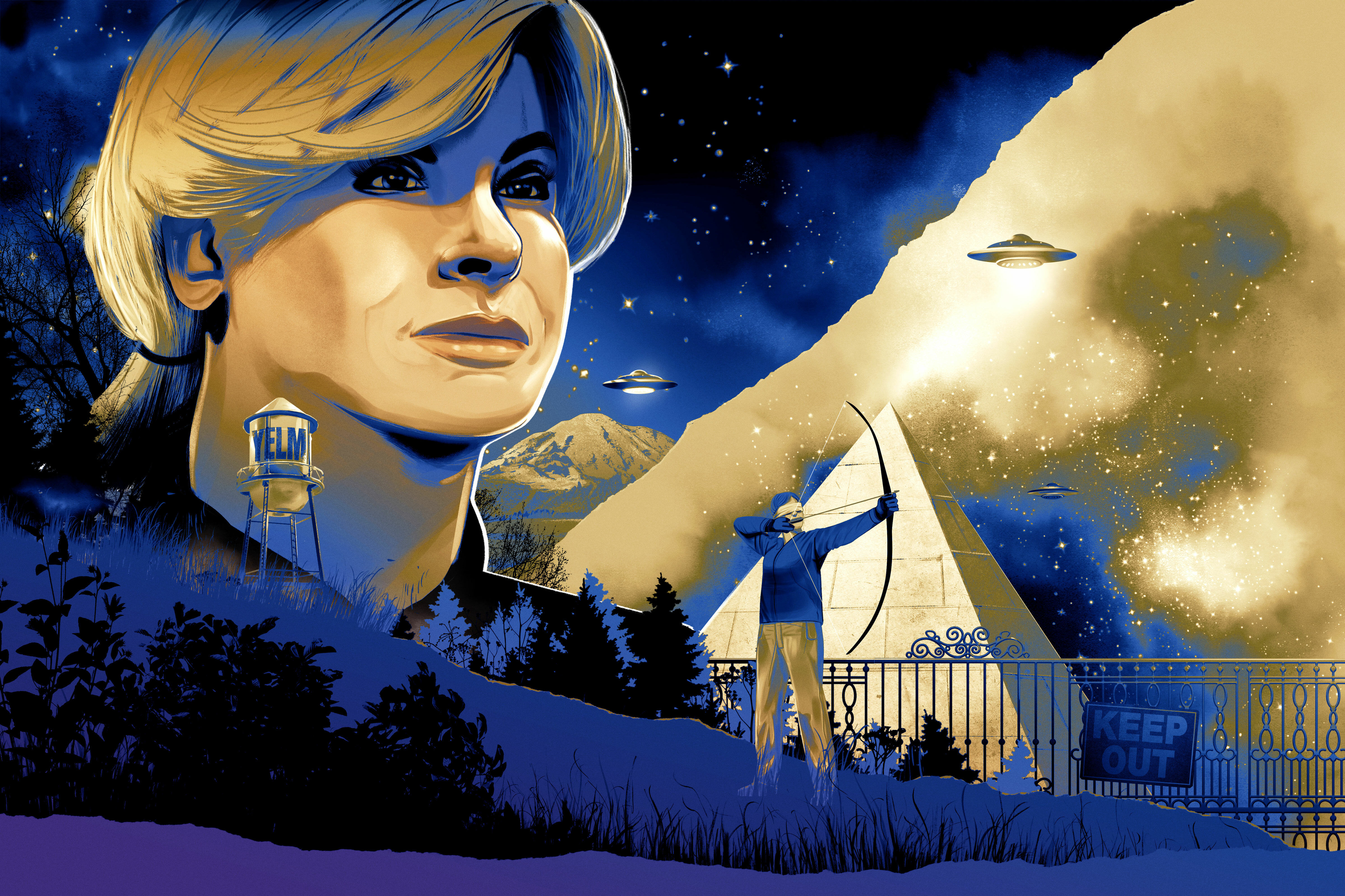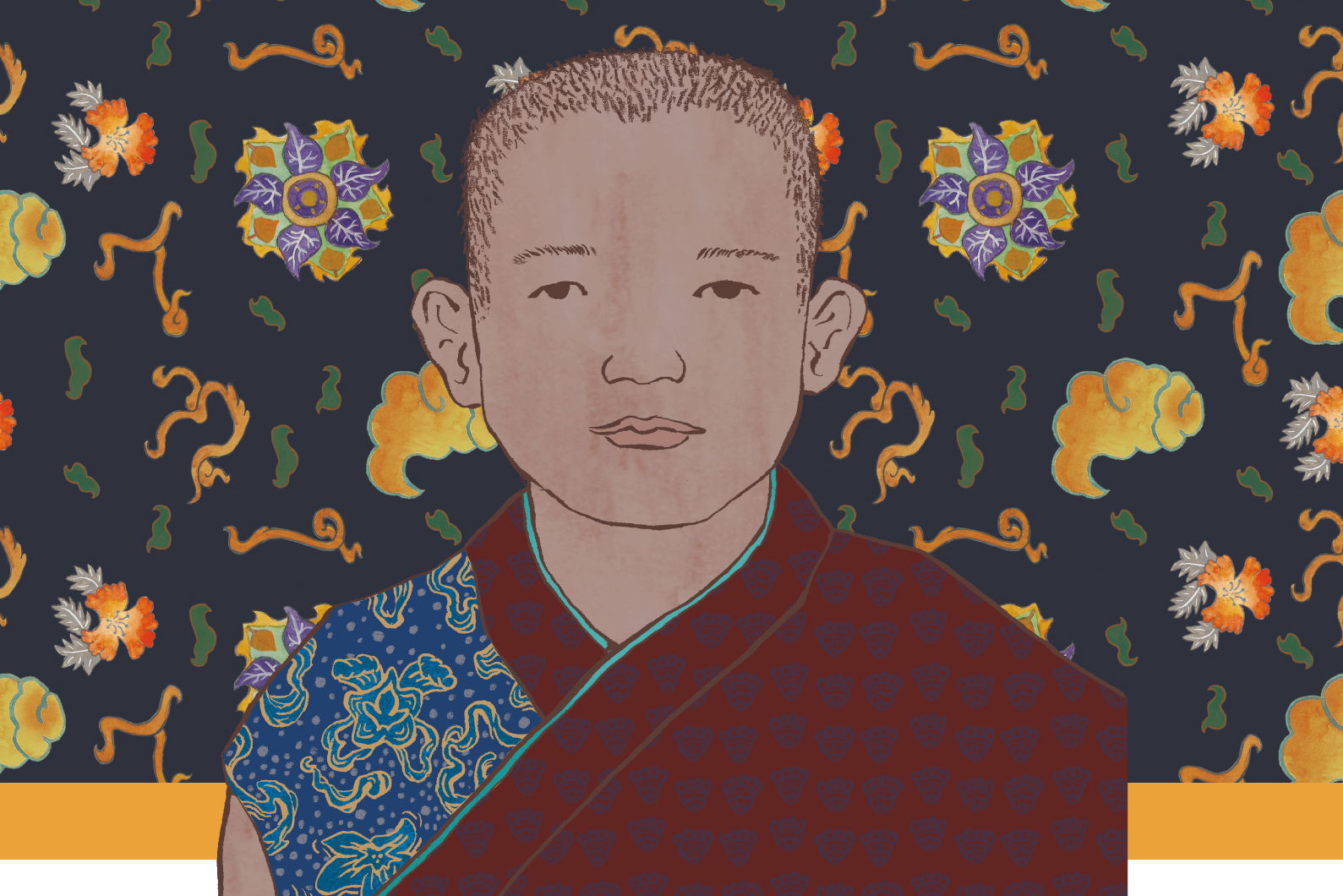
A Son Rises in the West
In the final years of his third life, Dezhung Rinpoche enjoyed short walks around the block near his home in Seattle’s Ravenna neighborhood. Dressed in the traditional maroon robes of a Tibetan Buddhist lama, he would shuffle along with the help of an attendant and the crutch that had been his constant companion since a botched knee surgery had hobbled him several years earlier. This was the mid-’80s, nearly a decade before Tibetan Buddhism would become a cultural phenomenon in the United States, so the sight of a robed holy man circumambulating the block would have inspired more than a few double-takes in this relatively enlightened enclave that borders the University of Washington.
Born Könchok Lhündrup in 1906, the Buddhist teacher grew up in the cold, arid foothills of east Tibet, with little in the way of scenery to distract him from his religious studies. But here in his adopted home—where he’d lived since 1960, originally as a guest of the UW—he was surrounded by greenery. And he cherished his afternoon sidewalk amblings for the opportunity they provided to soak up the flora he’d missed out on as a young man.
That bum knee made for tough sledding, though, so Dezhung Rinpoche made frequent stops, often hunkering down in a neighbor’s front yard. (A former neighbor found it so disconcerting to watch the lama regularly sully his robes in their wet grass that they began leaving out a lawn chair for his use.) It was during one of these pit stops that the aged man pulled close Adrienne Chan, his attendant and student for nearly a decade. He had decided where he would be reborn, and he wanted to share the news.
In the quarter century since fleeing his homeland, where the Chinese had set about burning Tibetan Buddhist monasteries in 1959, Dezhung Rinpoche had traveled extensively. He’d taught and studied throughout India and the United States, so according to tradition he could have honored any of those locations with his next reincarnation. But as Chan leaned in, Dezhung Rinpoche said simply, “I will be reborn in Seattle. It is nice and clean and fresh.”
Not long after, in May 1987, the lama died in Nepal. And then the wait for his return began.
Dezhung Rinpoche was four years into his fourth life when the country learned his name. You may remember him if you were a regular reader of The Seattle Times. Or The New York Times. Or USA Today. For six weeks 20 years ago, he was the most famous toddler in America.
Yet his rebirth in November 1991 went largely unheralded. There were no reporters, no cameras to document the occasion; at that point no one knew for sure who he really was. But even if they had, it’s possible he still would have been regarded as little more than a curiosity by anyone outside of the Sakya Monastery, the Tibetan Buddhist center in Greenwood where his parents practiced. The Dalai Lama was only two years removed from receiving the Nobel Peace Prize, and the faith had yet to break through into the American mainstream.
Two years later, the boy born Sonam Wangdu was formally recognized as Dezhung Rinpoche’s reincarnation, due in large part to a series of visions and dreams shared by his mother and the Sakya Monastery’s head lama. More than 4,000 people attended Dezhung Rinpoche IV’s enthronement in Nepal—his mother would later note that he behaved himself and even sat still for most of the ceremony—but still the media didn’t pounce.
It wasn’t until December 1995, shortly after Christmas, that Seattleites and the rest of the country took notice of the boy lama. His story had become newsworthy for two reasons. For starters, he was preparing to move to Kathmandu, Nepal—almost completely cut off from his family—where he would study the dharma for 20 years to continue on the path to enlightenment he’d presumably started three lives ago.
Then there was the matter of his family. His father, who died before Sonam’s second birthday when his car ran a red light and was struck by a Gray Lines tour bus downtown, was a Tibetan man named Tenzin Lama. His mother was white and grew up Catholic in small-town Indiana. And tucked into each story about Dezhung Rinpoche’s rebirth was the suggestion—sometimes overt, sometimes not so overt—that this American woman was shirking her biological duties by shipping off her young, innocent son to live out his childhood in the windswept tundra of eastern Asia. “Sonam will stay in the monastery, home to 38 monks, and live behind its eight-foot wall for five to eight years,” wrote USA Today’s Andrea Stone. “He will see his mother just twice a year, or whenever she can scrape together the $1,200 airfare.” The media had come for the mysticism and stayed for the moral outrage.
Save for a handful of television interviews over the next few years, the little lama’s mother retreated from the limelight and back to the relative safety of the monastery after he departed for Nepal. She’d said goodbye to her son willingly, but she lost a good deal of her dignity by force.
The forest was quiet, which was just how Carolyn Hawley liked it. She’d come to southeast Alaska more than two years ago, after divorcing her husband in 1986, to find peace and to watch the animals. They’d met at Purdue University—she was a rower and he was a rowing coach—and she promptly dropped out to support his dream of earning a law degree. (Self-study in Chinese philosophy was the only thing that really lit a fire in her, and she’d later joke that she was only there to get her “MRS degree” anyway.) Isaac was born in 1982, as their marriage rounded the five-year mark, but cracks were already starting to show in the relationship. Carolyn didn’t feel comfortable around her husband’s lawyer friends—she was a jeans and T-shirt type caught in a black-tie world—and she left when the pile of differences that mounted between them had grown too high to see around.
Living out here, with nothing more than a sleeping bag and a tent, Hawley could be alone. Which, honestly, was how she preferred it anyway. That way there was no one to start blabbing about nonsense and scare away the bald eagles that never asked anything of her in return.
Even if she couldn’t admit it at the time, though, she still craved connection, or at the very least a greater meaning in things. Hawley grew up as the middle child in a Catholic family and committed herself to the Bible’s teachings. Until, that is, the priest who taught her high school religion class blew her off when she started probing deeper to better understand what she was reading. She drew a hard line between faith and blind faith and decided then and there that she couldn’t waste her time on a religion that discouraged exploration.
Whether it was a search for purpose or a desire to help others or another force altogether, something made her stop as she came upon a truck broken down on the side of a dirt road one day that winter of 1988. The pickup belonged to a miner who was on his way to catch a ferry to Seattle, where he spent his winters. As they fiddled with the four-wheel drive, he explained that he was looking for a hand at the mine, but in the meantime she was welcome to join him in Seattle. There was nothing to keep Hawley in Alaska, so she agreed—but oh by the way, what’s in Seattle?
A little Tibetan Buddhist center north of downtown, the miner explained. The founders had moved into an old Presbyterian church a couple years earlier and could use another set of hands to help as they convert it into a monastery. As Hawley remembered her Chinese philosophy studies in college, she gave the idea of uprooting herself yet again little thought: Sure, let’s do it.
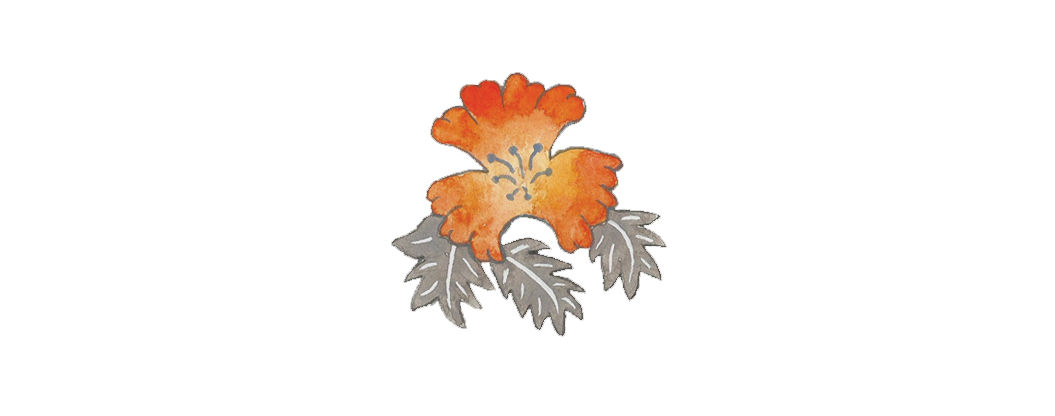
It has been a long time since the mother of Dezhung Rinpoche IV answered a reporter’s questions, and she isn’t exactly excited about the prospect of giving an interview now, all these years after finding herself in the middle of a debate about what it means to raise a child in the West. “You guys can really be not very nice,” Carolyn Massey says by phone from Indiana. (She reverted to her maiden name shortly after her son left for Nepal and moved home to care for her ailing mother in 2008.)
Initially, Massey did not respond to multiple phone calls and emails, but later agreed to speak to me only after I assured her older son, Isaac—now 33 and living most recently in Seattle—that my goal wasn’t to reopen old wounds. This was purely an attempt to see what had happened over the last two decades to the little lama who had, however briefly, become the subject of water cooler conversations throughout Seattle and across the country. Even with her concerns allayed, though, there would be no interview with Dezhung Rinpoche IV himself. He’s too busy and does not care to discuss his studies with the press.
In one of her last public appearances, in November 1997, Massey flew to Chicago for a taping of The Oprah Winfrey Show. She was there to talk about her son, of course, but the audience quickly made Massey and her “irresponsibility” the show’s true focus, despite calls for calm from Winfrey herself. The cruelest twist of the knife, though, came via pretaped segments in which Massey’s mother and one of her sisters unloaded on Carolyn for her willingness to let monks raise her little boy. “I don’t want to say Carolyn doesn’t want the responsibility,” her sister said, seething, “but I think it’s too easy to send him over there. And then she can come and go as she pleases.” Massey learned of her family’s disapproval at the same time the studio audience did.
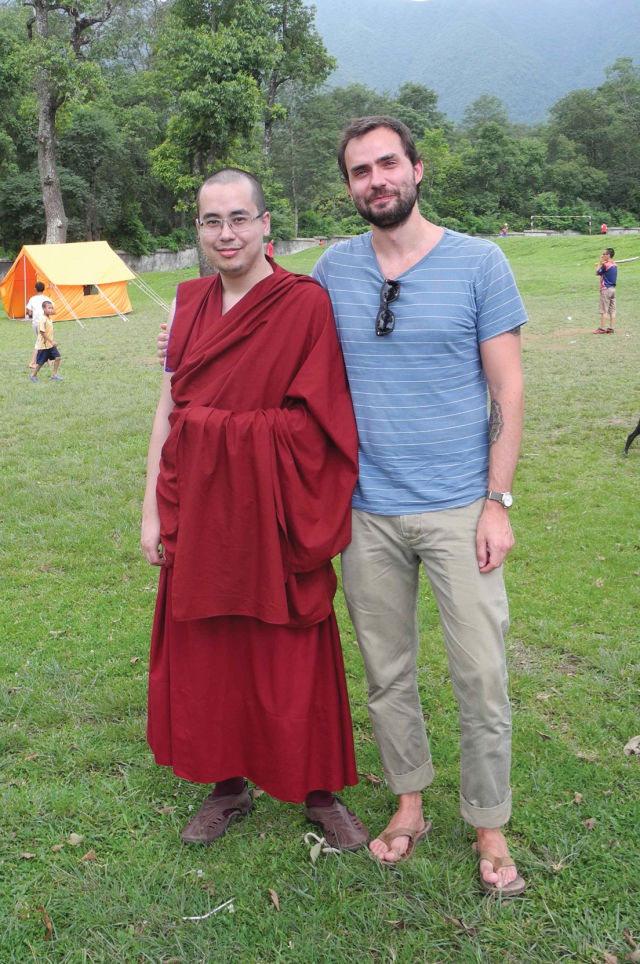
Isaac Hawley is in regular contact with his half brother, Dezhung Rinpoche IV, and has made a handful of trips overseas to visit, including in July 2014.
Photo courtesy Isaac Hawley
“Isn’t that mean?” she asks now, with a lilt in her voice that even all these years later straddles the line between wounded and incredulous. “I didn’t speak to my sister for two years after what she said about me on Oprah. But I’ve gotten over it. Buddhism helps you get over that kind of stuff.” She’d be happy to lend me her copy of the broadcast if only she could find it. (The segments with her sister and mom—the “controversial” bits—have been cut out, though.) Why she’s still holding on to that memento of her family’s betrayal she doesn’t say.
It’s not unreasonable to assume that the scorn heaped on Massey had roots in the public’s ignorance of Tibetan culture. Of course, that’s not to say Americans weren’t fascinated by it at the time. In the mid- to late-’90s Hollywood produced three major motion pictures about Tibetan Buddhism—one directed by Martin Scorsese (Kundun), one starring Brad Pitt (Seven Years in Tibet), and one based in Seattle, in which a white couple’s child is discovered to be a reincarnated lama (Little Buddha). “When Tibetan Buddhism came to the United States it appealed to a lot of people precisely because it was so different,” says Sharon Suh, the chair of Seattle University’s theology and religious studies department. “It’s so exotic in many ways and tied into fantasies about Shangri-la and the idea of the Himalayas being so far away and hard to reach. So there developed this lore and fantasy around Tibet.”
Which was all well and good for those who wanted to look but not touch. As soon as Tibetan culture began to merge with and subvert the ideals of faith and family that Americans clung to, though—as it did with Carolyn Massey—the fantasy became too real.
She was 35,000 feet above the ground when the plane began to materialize around her. As if a heavy fog was clearing, the cabin, the windows, the couch she was sitting on were suddenly just there. And beside her was her son, now 14 or 15. Carolyn Massey had no memory of getting on the plane and had no idea where they were going—she silenced the part of her brain that knew this was all a dream—but the joy she felt as they sat next to each other, reading, was all she really needed anyway.
Just as soon as she found herself in the air, she was on the ground again. The plane rolled to a stop, and when the door opened she saw the Sakya Monastery’s head lama standing on the tarmac. He was there to escort her son to a large auditorium that stood at the end of the runway. The lama didn’t explain anything, but he didn’t need to, either: Massey just understood that thousands of Buddhists had gathered here to receive teachings from the boy.
By itself this was a great honor. For so many people to recognize greatness in him at such a young age was dizzying—so much so that she forgot their bags after deplaning. But then, as she turned back to retrieve them, she saw a man whom she’d never met but felt as if she’d always known. The Dalai Lama, there to listen to her son speak, was walking toward her. And as she struggled to tamp down the pride and awe that threatened to overwhelm her, Massey bowed and stepped aside to let him pass.
Massey was living at the monastery and just barely pregnant when she received the first sign that she interpreted as an indication that her child might be special. The vision of Tibetan Buddhism’s most highly regarded teacher studying at the feet of her son still makes her giddy. “It was like, oh my gosh, His Holiness is going to receive teachings from my son!” Massey remembers thinking. On its own, the vision meant very little. It needed verification. “I could have had a dream that he was the King of England, and it’s not going to make a crown come to his head,” she says. “It’s what they dream that matters.”
By “they,” she means the leadership of the Sakya Monastery, particularly its head lama, Jigdal Dagchen Rinpoche. (Rinpoche is a title typically bestowed upon lamas that translates to “precious one.”) Dagchen Rinpoche, now 86, founded the monastery with Dezhung Rinpoche III in 1974, and the two were very close. He speaks little English, so his son, Ani Sakya, translated when we met in November 2015. A dream, he explained, can be just a dream. “But at the same time, it’s like the Buddha says: Examine everything,” Sakya said. “And in this case, a woman who is very devout—who doesn’t have dreams like this normally—had these dreams that were so vivid and so strong. So from there, they listen.”
Although Massey contends that from the time of his conception, there was no doubt that Sonam was the reincarnation of Dezhung Rinpoche, Dagchen Rinpoche says there were actually two other candidates born the same year: one in Canada and another in India. And while it’s true that Dagchen Rinpoche believed strongly that Sonam was the one—his personality and his attitude matched Dezhung Rinpoche III’s, even at a young age—the boy had to pass one more test.
At a private residence in New Delhi, India, young Sonam was presented with a collection of religious items that belonged to Dezhung Rinpoche III—rosary beads, a bell—as well as duplicates that belonged to other deceased lamas. And without offering any instruction, Dagchen Rinpoche watched the boy to see if he would choose the “right” artifacts. He did. “Only a person who owns these things would be able to pick them,” Ani Sakya says.
This business of religious leaders reborn in the bodies of young boys is one of the foundations upon which Tibetan Buddhism is based, but that doesn’t mean it’s always an easy one to accept in Judeo-Christian society. It’s not easy to accept for even some of the faith’s strictest adherents. As an 18-year-old, Stephen Batchelor left his home in Great Britain to join a monastery in India. He has written nine books on Buddhism in the intervening 40-plus years and, along with his wife, teaches classes around the world. Reincarnation, though, has him stumped. “It makes very little sense to me,” he says via Skype from France, where he lives these days. “I don’t understand how it could conceivably work, given the way we currently understand the human organism.”
Instead, he says, it’s helpful to view the recognition of reincarnated lamas as a process by which the Tibetan Buddhist faith ensures its own survival. “The little boy and the reincarnation, that’s almost a side story,” he says. “It’s well acknowledged in Tibetan culture that sometimes the boy works out to be a really good choice. And other times he doesn’t give two hoots about Buddhism.”
Massey is conflicted too, but only about her role in the lama’s rebirth. On one hand, she says she would never presume to think that she could be the vessel through which someone so special or important could return to earth. “I am as average as you could possibly get,” she says. “I pity the kid that would be born to me.” On the other hand, she’s not the least bit surprised that it happened. “I might be humble, but I’m not dumb. I know logically that I would be a very good choice, because I’m a good person and I’m a very loyal Buddhist.”
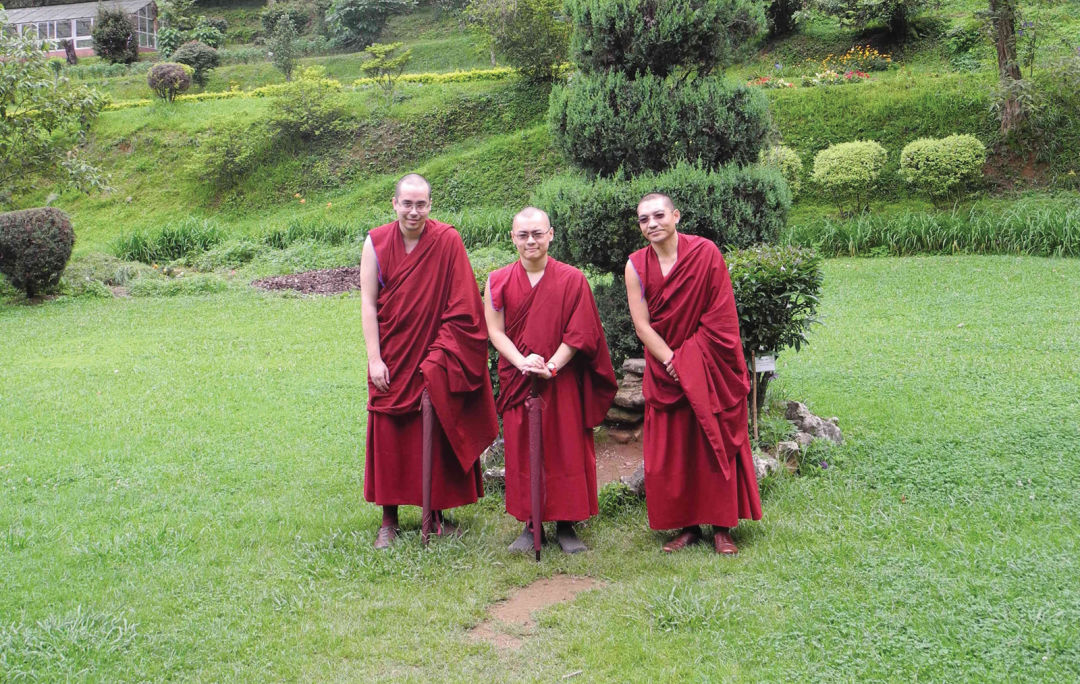
If Dezhung Rinpoche IV was at all apprehensive about leaving the comfort of a life filled with cartoons and Cheerios, he didn’t show it when he arrived in Nepal in January 1996. Dressed in gold and maroon robes and riding on a luggage cart pushed by his mother, the little lama smiled widely for the reporters who had gathered at Tribhuvan International Airport in Kathmandu to document the beginning of his new life.
While Carolyn Massey stopped to answer questions from the assembled media, a monk from the Tharlam Monastery whisked the four-year-old into his arms for the short trip to a waiting car. Dezhung Rinpoche IV wasn’t royalty but he was revered, and his attendants weren’t about to make him walk.
For the next several hours, with cameras still rolling, his smile faded only occasionally, like when each of his 38 monks presented him with a khata, a silk scarf symbolizing compassion and—in this case—congratulations. As is custom, Dezhung Rinpoche IV returned each to the giver, draping it around the bowing monk’s neck. But as the ceremony continued the little lama grew tired of the repetition and began haphazardly tossing the scarves back, grumbling under his breath—but loud enough for the cameras to pick up—“Too many monks. Stupid monks.”
When asked how long he would stay in Nepal, though, the little boy was serene, almost stoic. “Lots of time,” he said. “I’m just going to stay here a long time. Lots of time. I’m not going to go. I’m not going.”
Dezhung Rinpoche wasn’t the first reincarnated lama to be discovered in the West. Ösel Hita Torres was born in Spain to an ethnically Spanish couple in 1985. Simon Heh, the son of Tibetan and Chinese immigrants, followed three years later in Los Angeles. Jack Churchward, whose Caucasian parents lived in Florida, preceded them both—though it wasn’t until age 17, after arrests for shoplifting and marijuana possession, that he finally embraced his birthright. None drew the amount of intense attention that Seattle’s little lama did, though, no doubt because his mixed ethnicity—Tibetan and white—made him so unique. And none of his predecessors straddled two worlds the way he did, torn between responsibility to religious custom and the expectations of a culture that values family above all.
Perhaps coincidentally, the Western-born lama whose story most closely mirrors Dezhung Rinpoche’s is also from Seattle. Tulku Ogyan Kyab was born in May 2010 to Laura Ellis, a Seattle resident for more than two decades, and Tsering Lama, who can trace his family tree back hundreds of years in eastern Tibet. Both have been students of Dagchen Rinpoche’s at the Sakya Monastery since the early 2000s. And neither had second thoughts about sending their son to a monastery in India shortly after his fourth birthday. For them it’s a numbers game. “I go to work every day, and I can maybe help one or two people. I’m not a doctor who can cure others’ sickness, physically or mentally,” Lama says. “But my son, he’ll benefit thousands, tens of thousands—millions of people in his lifetime.”
Laura Ellis and Carolyn Massey became friends not long after Ellis joined the monastery in 2002, and the two have remained in touch since Massey left for Indiana. So now when Ellis has her “freak-out moments,” she has someone to call.
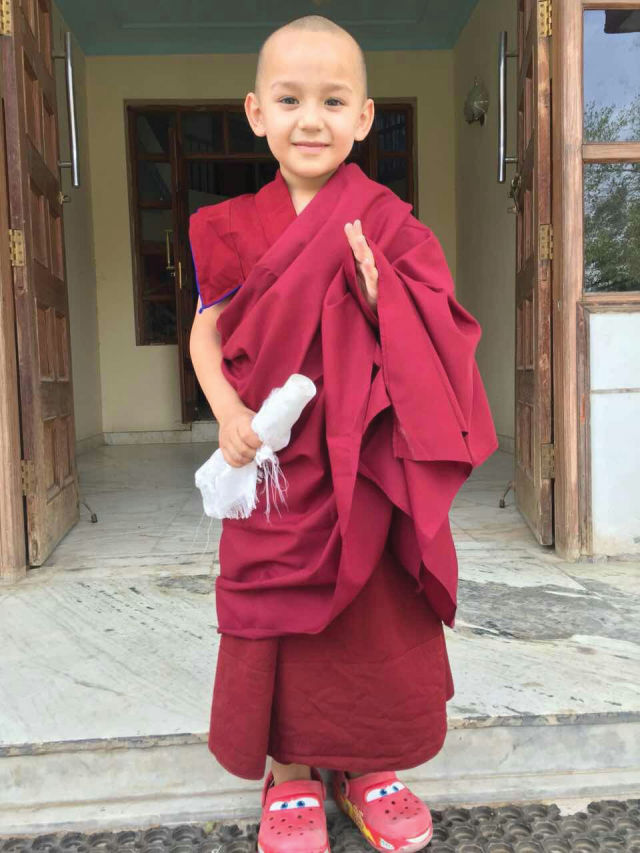
Tulku Ogyan Kyab will be enthroned in Tibet in summer 2016.
Photo courtesy Laura Ellis
Massey doesn’t have freak-out moments anymore. Early on she would break down on the plane after visiting her son, sometimes so intensely that the flight attendants had to check to make sure she was okay. And a care package of soaps and other trinkets sent from Nepal could reduce her to a blubbering mess. Before he moved away, she would lie down with him to keep him company before he fell asleep in their room at the Sakya Monastery. Each time, as he drifted off, his little hand would find the same mole on the outside of her right arm and trace its outline. It reminded Massey of the way her older son, Isaac, would play with her eyelashes as he fell asleep, and when she thought about it in those first few years after the little lama’s departure it was a source of both comfort and longing.
The pain never made her doubt her decision, though—thanks largely to her faith. “We have sort of a saying in Buddhism: Whatever is accumulated is consumed. Whatever rises must fall. Whatever is united is separated. Whatever is born eventually dies. So this is just part of life. Whether it’s your kids growing up and moving on or your mother dying or your sister moving away, you’re not going to be with everybody forever.”
Buddhist teachings can only explain so much of Massey’s willingness to let Dezhung Rinpoche IV go, though. She’s done this before, prior to finding the faith, when she and her first husband divorced and she left Isaac with him. At the time of the little lama’s departure, the press used that fact to underscore the narrative that she was an irresponsible woman, unwilling to care for her own flesh and blood. To hear her explain it now, though, both decisions were born out of her own self-doubt. “Isaac’s dad remarried and had a very conventional life, so we didn’t see each other a whole lot,” she says. “I think you do what you have to, to make people in your life have the best life possible.”
Her life has never been easy. Without a college degree she worked odd jobs in Seattle and called the monastery home. She’s led a spartan lifestyle since returning to Indiana, most recently caring for the children of a physician couple during the day and sleeping in their mother-in-law unit at night. What kind of a mother would she have been, she argues, if she’d kept her son here and denied him the chance to fulfill his destiny? “What you really want for your children is for them to be happy. And [continuing his studies] was a much happier life than he would have had with me.”
Ironically, Massey is more concerned about what will become of her son after his studies are complete than she was about parting with him 20 years ago. The two talk regularly by phone (“You don’t know how many numbers you have to push,” she says with a laugh. “It’s terrible.”), and he often speaks about the pressure he feels to live up to expectations. It’s one thing to be compared to, say, your successful businessman father. It’s another thing entirely to be compared to your three previous incarnations, all of whom spent a lifetime studying how to guide others toward enlightenment.
So Dezhung Rinpoche IV isn’t about to rush anything. His mother expects that once his studies are complete, he’ll travel Asia and the United States, teaching the dharma; that he’s multilingual will only make him that much more effective as a teacher. “Having to have everything you say translated to English is a big deal in a teaching,” she says. “So if your lama can speak fluently in English, it’s fantastic.” For the time being, he has decided to stick around in Nepal for at least another two or three years. “I have to keep telling the monastery in Seattle, ‘Please don’t ask him to come teach. He’s not ready yet,’” Massey says. “It’s like a wine that you don’t want to uncork before it’s ripe, before it’s seasoned or whatever.”
Carolyn Massey was a live wire of emotion on her first trip to visit her son after he’d left Seattle for good. Anticipation, excitement, heartsickness, nervousness, doubt—it was hard to tell which one would win out. She’d stayed in Nepal for two months after the move to get him settled and help his attendants adjust to raising a boy whose world to that point had been dominated by Power Rangers and Thundercats.
Leaving then was excruciating, but returning was just as emotional. Thoughts of holding him mixed with concerns about how he would react to seeing her all these months later. She would always be his mother, but would his new monastic life have made him distant? It seemed impossible, but would he have moved on? Would he…remember her?
Those worries swirled in her head and made her dizzy as she walked into the Tharlam Monastery and looked to the throne where she’d left him five months earlier. But when he saw her he didn’t hesitate. She kneeled down to accept his embrace, and when his fingers went to that mole on her right arm she knew. He had a new home, but a part of him would always live with her.

